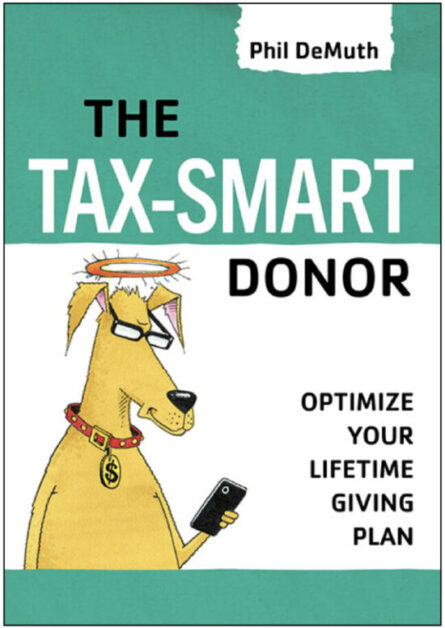The Tax-Smart Donor: Optimize Your Lifetime Giving Plan. 2025. Phil DeMuth. Alpha Dog Press
Charitable giving is a way of life for many individuals and families. According to Giving USA 2024: The Annual Report on Philanthropy for 2023, more than $550 billion was donated, which includes more than $374 billion by individuals. The largest recipients were religious organizations, with more than $145 billion in donations.
Despite the generosity of Americans, most individuals give inefficiently, thus reducing the impact of each dollar they spend. This is a problem for all but the ultra-wealthy, who are likely to have an army of attorneys, accountants, and financial advisors to assist in optimizing their giving. Even many of us who have studied and worked in the financial industry for decades are inadequately trained in the intricacies of charitable giving. Textbooks in investments generally make no mention of charitable giving, while the topic is beyond the purview of the CFA Program. Even the Certified Financial Planner program makes only a limited reference to charitable giving by briefly discussing some vehicles, such as charitable lead and charitable remainder trusts.
This lack of coverage of the topic has left a void in financial planning. Fortunately, Phil DeMuth of Conservative Wealth Management LLC, a firm that caters to high-net-worth investors, has undertaken to fill that void with The Tax-Smart Donor: Optimize Your Lifetime Giving Plan.
Many of the issues that make tax-smart donations difficult result from the Tax Cuts and Jobs Act of 2017, which raised the standard deduction and limited certain deductions such as mortgage interest and state and local property taxes. With more taxpayers unable to meet the threshold for itemizing, many individuals are spending more than $1 to give $1 to their favorite charity, something DeMuth refers to as negative giving power.
Some strategies for tax-efficient donation are well known, e.g., giving appreciated assets or bunching contributions in one year. The key to doing this successfully is knowing what assets to donate and how to bunch donations. The Internal Revenue Service tax code has strict guidelines on the amount that can be donated, and these amounts differ depending on the type of asset donated and the type of vehicle used for the donation.
DeMuth has broken the book into twelve chapters covering topics such as giving by cash and check, donating securities, retirement account philanthropy, and gifts of property. Different rules and regulations guide the various forms of giving. In many cases, a charity is likely to prefer regular, predictable giving rather than large occasional donations.
The easiest way to donate in a tax-advantaged manner is to use a donor-advised fund (DAF), a vehicle pioneered by New York Community Trust in 1931. DeMuth explains that DAFs are easily created through investment company giants such as Fidelity, Vanguard, and Schwab, which will manage the money and handle all the relevant paperwork. Vanguard requires a modest $25,000 to open the account and a minimum of $5,000 to add to the account, while Fidelity and Schwab have no minimums for either.
Many of the strategies in the book apply to a wide range of individuals. The author points out in his chapter on charitable trusts, however, that they apply only to very wealthy individuals, given their cost and complicated structure. For example, a charitable lead annuity trust (CLAT) is not a charity and is subject to capital gains tax. Who pays the tax depends on whether the CLAT is a grantor trust or a non-grantor trust. Although charitable trusts are not for most individuals, it is not uncommon for universities to encourage alumni to consider them.
Throughout the book, DeMuth provides tables to compare the impact of different types of giving. Donations of property, cash, and retirement savings are all subject to numerous rules and regulations. DeMuth takes the reader through the procedures that the donor must follow to receive the tax benefits of the donation. The lesson is that the IRS is unforgiving, and mistakes cannot be undone later. Donors may think they can provide documentation at a later point, e.g., appraisals and letters from the recipient, but that is not the case.
In the chapter titled “Three Scenarios for Tax Strategy,” DeMuth takes readers through the life of a fictitious individual, Renee, across various ages and with varying degrees of wealth. In each situation, he discusses whether Renee can afford to make charitable contributions and, if she can, how she can get the most bang for each donor dollar.
The moral of the book is that charitable giving should be part of a lifetime plan, which may include waiting until it is most beneficial to give. The decision to defer giving may entail holding off until one has sufficient earnings and wealth, or until giving power is the greatest.
Some individuals may choose to wait to give because they believe they can more effectively grow capital than most charities. Recognizing this, DeMuth provides a chapter on investing for charity. Most charities struggle to generate returns, so some individuals may feel they can do better by waiting to give and investing the funds themselves. Warren Buffett has successfully used this strategy, refraining from giving in the thousands or millions early in his career so that he could give tens of billions later in life.
Although it is unlikely that anyone reading The Tax-Smart Donor will generate the kinds of returns Buffett has over his lifetime, his deferred approach may be a viable strategy for some types of giving. It could, for example, be a sound plan for donating to one’s alma mater, which might be willing to forgo annual donations in the thousands for a seven-figure donation several decades in the future. It is hard, however, to imagine informing one’s local pastor that waiting could mean a six- or seven-figure donation to the church three decades from now.
In summary, DeMuth has produced a book that fills a void in the literature on financial planning by providing the reader with an understanding of the most effective ways to give to charity. It is an excellent reference for financial advisors, who may wish to provide some insight into questions from clients on charitable giving, as well as a valuable source for anyone who wishes to use the tax code to be a more effective donor.



























